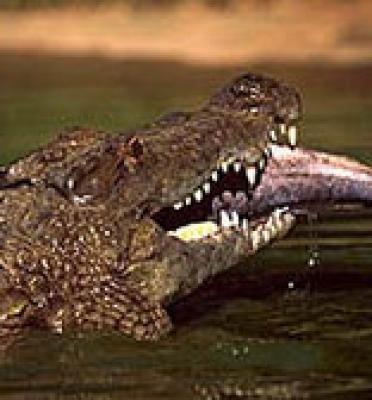Situated some two km north of St Lucia village on the road to Cape Vidal, the Crocodile Centre offers an exciting and informative outing for visitors who would like to know more about the lake system and one of the world's oldest and most fascinating animals, the crocodile.
Displays
A series of displays and dioramas depict the Lake St Lucia system. These cover the sea, beach, dune forests, grasslands and the lake shore.
A series of informative displays on the Nile crocodile provide details about the breeding, feeding, physical structure and distribution of this prehistoric creature. Aquaria hold examples of living organisms which are found in the mangrove swamps, rock pools along the seashore and freshwater pans.
Role
The centre interprets the Lake St Lucia system and the habits of the crocodile and serves as a centre for crocodile monitoring and research. Staff also contribute to the development of the crocodile farming industry in Natal. Crocodiles are a protected species in Natal and problem crocodiles are captured and translocated rather than destroyed.
Crocodile ponds
In the various ponds all the African species of crocodile can be seen; the Nile, long-snouted and the dwarf crocodile. For comparison there are also American alligators. The crocodiles on display range in size from hatchlings to specimens of up to four metres.
Nile crocodile
The Nile crocodile occurs throughout Africa and is the only species found in South Africa. It is the largest of the African crocodiles and can grow to six metres in length.
Long-snouted crocodile
This crocodile occurs in West and Central Africa where it lives in rivers in forests or in swamps. They grow to lengths of up to four metres. The specimens kept at the centre form part of an international breeding bank.
Dwarf crocodile
These occur in the rain forests of West and Central Africa. They are the smallest African species and reach lengths of up to two metres and are also held in this centre as part of an international breeding bank.
Feeding
Crocodile feeding for public demonstration takes place on Saturday afternoons at 15hOO (weather permitting) as well as on Wednesday evenings at 18h30. The evening feeding is only during the summer months.
Breeding
Crocodiles breed during the summer months. The females lay their eggs in November and December and can be seen lying near or on the nest which they guard aggressively. It takes the eggs 90 days to hatch. The females open the nests and carry the hatchlings to the water in their mouths.
Trails
The route through the centre is a short trail where many of the trees to be found on the Zululand coast can be seen. The centre attracts a large variety of birdlife and during the breeding season, spotted and thick-billed weavers nest here in large numbers. In the adjacent game park a number of linked trails provide walks of half an hour to two hours duration. Along the trails a number of animals such as reedbuck, impala, zebra, blue wildebeest and hippopotamus can be seen. A large variety of water birds frequent the pans in the region.
Curio Shop
A large, well-stocked curio shop offers an interesting selection of books and souvenirs. A range of traditional Zulu crafts may appeal to the overseas visitor.


